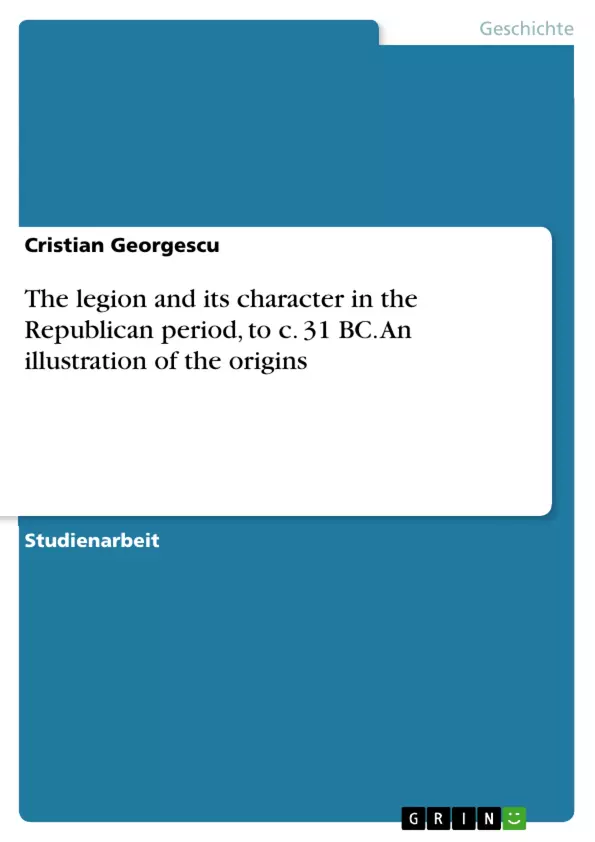This seminar paper examines the origins of the legion and its character and exploits through the expansion of the Roman empire in the Republican period, to c. 31 BC. However, these legions were ad hoc units within a citizen army, raised on a temporary basis for campaigns and had no lasting identities that we can describe over a period of centuries. Legions as units with stable, long-term histories emerged from the armies of Julius Caesar in Gaul in the mid-1st century BC and of Octavian and Mark Antony in the civil wars of the 40s and 30s BC.
Portraying the Roman imperial Army during the reign of the second emperor, Tiberius, in AD 23, the Roman historian Tacitus enumerates the twenty-five legions that made up the heart of the army, with the areas of the empire in which they were installed. Tacitus also says that there were similar naval units and units of supporting cavalry and infantry ‘not much inferior to them in strength.’
However, Tacitus allocates most attention to the legions, describing their placement region by region, while he explains over the other elements of the armed forces in a couple of sentences. And it is exactly the legions of the Roman army that come to our minds when we think about Roman military strength and effectiveness.
For the Roman historian Tacitus, the legions were vital because they were the high-status units of the army. They were composed of Roman citizens with full Roman legal and political rights, and they still represented the Roman people under arms. Auxiliary troops were recruited largely from allies and subjects, men of mediocre status who aimed to Roman citizenship after a lifetime in the army. Equally important is the fact that in AD 14 the legions already had a history of over three centuries of success. They had formed the core of an army that had boosted Rome from anonymity to domination of the Mediterranean basin and beyond. They had beaten Hannibal, the Macedonians, the Gauls and many others.
The Roman legions had suffered defeats too, but one Roman feature was the capacity to endure losses and rebuild fighting strength, so the legions lived on. They lived on and fought well beyond the age of Augustus. Legions were still essential fighting units in the 5th century AD, when the western empire was in military and political decline.
Inhaltsverzeichnis
- Introduction
- The Roman Legions from Romulus to Marius
- Polybius and the ‘Manipular’ Legion
- Organization of the Manipular Legions
- The Manipular Legion in Battle
- The ‘Marian’ Reforms of the Legions
- The Homogenization of the Legions
- Recruitment of the Legions
- Caesar’s Legions, 58-44 BC
Zielsetzung und Themenschwerpunkte
Diese Seminararbeit untersucht die Ursprünge der römischen Legion und ihre Entwicklung im Verlauf der römischen Expansion während der Republik bis etwa 31 v. Chr. Die Arbeit beleuchtet die charakteristischen Merkmale und Leistungen dieser militärischen Einheit und verfolgt ihre Transformation von ad-hoc-Truppen zu einem dauerhaften und effektiven Bestandteil der römischen Kriegsführung.
- Entwicklung der römischen Legion von ihren Anfängen bis zur späten Republik.
- Die Rolle von Polybios und die Beschreibung der „Manipularlegion“.
- Die „Marianischen Reformen“ und ihre Auswirkungen auf die Organisation und Rekrutierung der Legionen.
- Die Legionen von Julius Cäsar und ihre Rolle in den gallischen Kriegen und den römischen Bürgerkriegen.
- Die Bedeutung der Legionen für den Aufstieg und die Expansion des Römischen Reiches.
Zusammenfassung der Kapitel
Introduction
Die Einleitung führt in das Thema der römischen Legionen ein und beschreibt ihre Bedeutung für die Geschichte des Römischen Reiches. Sie stellt fest, dass die Legionen den Kern der römischen Streitmacht bildeten und zu ihrem Aufstieg zur Weltherrschaft beitrugen. Die Arbeit konzentriert sich auf die Ursprünge und die Entwicklung der Legion bis etwa 31 v. Chr.
The Roman Legions from Romulus to Marius
Dieses Kapitel untersucht die frühen römischen Legionen von ihren mythischen Anfängen bis zur Beschreibung durch Polybios im 2. Jahrhundert v. Chr. Es beleuchtet die Organisation, Ausrüstung und Kampfweise der „Manipularlegion“ und ihre Rolle in den punischen Kriegen und anderen Konflikten.
The ‘Marian’ Reforms of the Legions
Das Kapitel behandelt die Reformen, die Gaius Marius in der Mitte des 2. Jahrhunderts v. Chr. durchführte, um die Legionen zu modernisieren und ihre Effektivität zu steigern. Es konzentriert sich auf die Homogenisierung der Legionen, die Änderung der Rekrutierungsrichtlinien und die Bedeutung dieser Reformen für die Entwicklung der römischen Kriegsführung.
Caesar’s Legions, 58-44 BC
Dieses Kapitel untersucht die Legionen von Julius Caesar während seiner gallischen Kriege und den römischen Bürgerkriegen. Es beschreibt die Zusammensetzung und Organisation der Legionen Cäsars, ihre Rolle in den Schlachten und die Bedeutung ihrer langfristigen Existenz für das Römische Reich.
Schlüsselwörter
Römische Legion, Manipularlegion, Marianische Reformen, Julius Caesar, Gallische Kriege, Bürgerkriege, Organisation, Ausrüstung, Rekrutierung, Taktik, Strategie.
- Quote paper
- Cristian Georgescu (Author), 2019, The legion and its character in the Republican period, to c. 31 BC. An illustration of the origins, Munich, GRIN Verlag, https://www.grin.com/document/1037269



